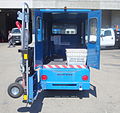2011 Ford E250 Cargo Owner Guide 3rd Printing - Page 271
2011 Ford E250 Cargo Manual
Page 271 highlights
Maintenance and Specifications Add the proper mixture of coolant and water to the cooling system by following these steps: 1. Before you begin, turn the engine off and let it cool. 2. When the engine is cool, wrap a thick cloth around the coolant pressure relief cap on the coolant reservoir (a translucent plastic bottle). Slowly turn cap counterclockwise (left) until pressure begins to release. 3. Step back while the pressure releases. 4. When you are sure that all the pressure has been released, use the cloth to turn it counterclockwise and remove the cap. 5. Fill the coolant reservoir slowly with the proper coolant mixture, to within the COLD FILL RANGE or the FULL COLD level on the reservoir. If you removed the radiator cap in an overflow system, fill the radiator until the coolant is visible and radiator is almost full. 6. Replace the cap. Turn until tightly installed. Cap must be tightly installed to prevent coolant loss. After any coolant has been added, check the coolant concentration (refer to Checking engine coolant). If the concentration is not 50/50, drain some coolant and adjust the concentration. It may take several drains and additions to obtain a 50/50 coolant concentration. Whenever coolant has been added, the coolant level in the coolant reservoir should be checked the next few times you drive the vehicle. If necessary, add enough 50/50 concentration of engine coolant and distilled water to bring the liquid level to the proper level. If you have to add more than 1.0 quart (1.0 liter) of engine coolant per month, have your authorized dealer check the engine cooling system. Your cooling system may have a leak. Operating an engine with a low level of coolant can result in engine overheating and possible engine damage. Recycled engine coolant Ford Motor Company does NOT recommend the use of recycled engine coolant since a Ford-approved recycling process is not yet available. Used engine coolant should be disposed of in an appropriate manner. Follow your community's regulations and standards for recycling and disposing of automotive fluids. Coolant refill capacity To find out how much fluid your vehicle's cooling system can hold, refer to Maintenance product specifications and capacities in this chapter. 271 2011 Econoline (eco) Owners Guide, 3rd Printing USA (fus)
















